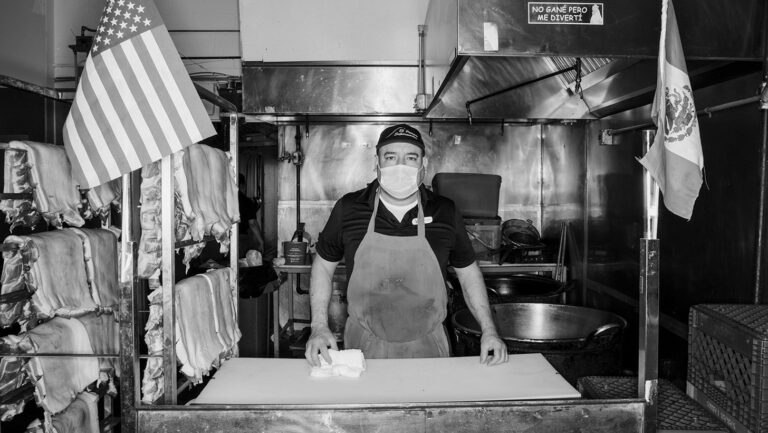The tiny but immaculate Q-Staff Theatre, on the other hand, serves as home to the Q-Staff Performance Group, a company made up of three members—Rich van Schouwen, Sandy Timmerman and Bryan Jabaay—that formed in 1999. Like MTS, Q-Staff specializes in melding music with theater, but the comparison ends there. They might be located just a few yards from each other, but MTS is as remote from Q-Staff as Albuquerque is from the dark side of the moon.
A while back, I caught a Q-Staff show at Winning Coffee House called Temporality. Although that production was highly inventive, it didn't do much for me. It seemed disjointed and awkwardly self-conscious—a random mishmash of performance art bits and occasional weird musical numbers. Van Schouwen recently explained to me that Temporality was a rough work-in-progress involving several performers outside the core of the company. This may explain its painful lack of polish.
Q-Staff's current production, Snake Oil for the Lovelorn, pleasantly surprised me. Although it uses many elements found in the earlier show—odd music, stylized movements, absurdist props and elements reminiscent of primal rituals—this is an entirely different beast. Van Schouwen, Timmerman and Jabaay all train, work and live together. Their intimacy and comfort with each other reveals itself in every moment of this performance.
Audience members aren't allowed into the actual theater until precisely 8:30 p.m. At that moment, the doors pop open and Van Schouwen emerges, drenched in sweat, wearing black and white clown pants and carrying a pair of shiny chrome fire extinguishers.
He breathlessly announces he needs two volunteer fire marshals to use the extinguishers should anything, or anyone, burst into flames during the show. After deputizing two marshals, Van Schouwen begins ushering people into the theater in twos and threes.
Through the double doors, the first thing we notice is that the performance is already in progress. Timmerman and Jabaay, hands locked, twirl around on the hard wood floor in some kind of dreamy, acrobatic swing dance. Like Van Schouwen, they're both really sweaty. Walking in on them gives you the impression that you're stepping into the middle of a ritual that's been going on long before you arrived and will continue long after you leave.
The scent of the room is intense, a natural woody smell that seems to rise up from the wood floor itself. We sit down on rows of rough hewn wood benches arranged around much of the perimeter of the room. Some high scaffolding stands in one corner. A satellite dish is mounted in another corner. Looking around, I see a little wood wagon, a strange lamp ornamented with long plastic strands, a step ladder mounted on rollers, a giant metal drum and several instruments—a tuba, a guitar, a saxophone, a flute and a xylophone.
It's hard to explain what happens next, but music is at the center of everything. Over the next 70 minutes, the trio links various vignettes together into a lightly connected chain. They set up altars. They break them down. They move and dance around each other.
We hear some prerecorded electronic music, but the three performers mainly provide their own live music, singing three-part harmonies and playing the instruments carefully arranged around the room. The sounds they produce are always interesting and often spectacular. At one point, they skip around the room in a row singing a hauntingly beautiful a cappella tune. At another point, Van Schouwen picks up the tuba, Timmerman the flute and Jabaay the saxophone, and they launch into a melodic instrumental ditty as they prance around each other in the middle of the floor.
Almost everything on stage serves some kind of sonic purpose. The floor itself is the main percussion instrument as each member of the trio takes turns slapping or sliding their bare feet to the beat on the smooth, hard wood.
From soap bubbles to severed doll heads, surprises spring out at us from everywhere. The trio perform a series of circus tricks including flame blowing and various acrobatics. More than anything, Snake Oil for the Lovelorn seems to resemble an old-time medicine show—if the medicine show were performed buy a bunch of musically talented, schizophrenic escapees from a mental hospital.
The most dramatic moment comes when Jabaay murders Timmerman with a long trill of dissonant saxophone wheezes, forcing her body into a convulsion of terrifying seizures before she collapses lifeless to the floor. She's later brought back to life with a few drops of snake oil.
As far as I can tell, the show seems to revolve around this kind of ritualized renewal. Then again, Snake Oil for the Lovelorn evades any sort of easy explanation. This might be because the spoken parts, to my ears, are largely incoherent gibberish. They're certainly the least interesting aspects of the show, but they're tangential anyway. Taken as a whole, there's definitely something entrancingly irresistible about this performance.
Is this genius or just self-indulgent insanity? It might be a little of both. Snake Oil for the Lovelorn isn't for everyone. Your mother might be offended. Your brother might be bored. Your closest friend might ridicule your questionable sense of taste. But what do they know? If you're looking for something that bravely attempts to annihilate the established conventions of theatrical and musical performance, you need look no further.
Snake Oil for the Lovelorn runs Fridays through Sundays at 8:30 p.m. through Oct. 10 at Q-Staff Theatre (4819 Central NE). $10 suggested donation (requested after the show only from those who enjoyed it). 255-2182.








